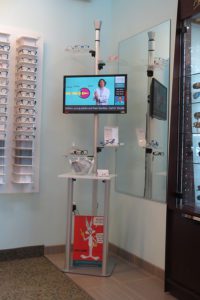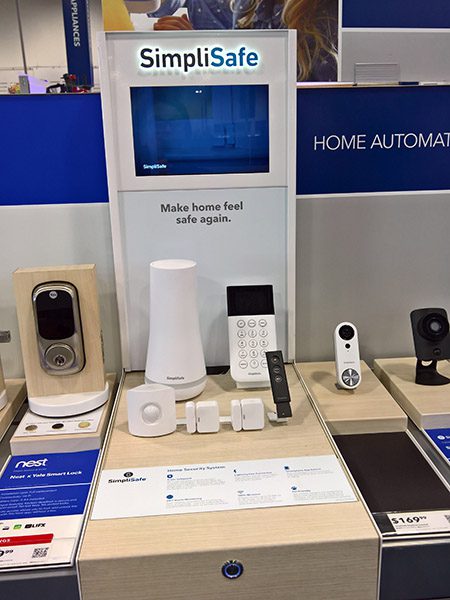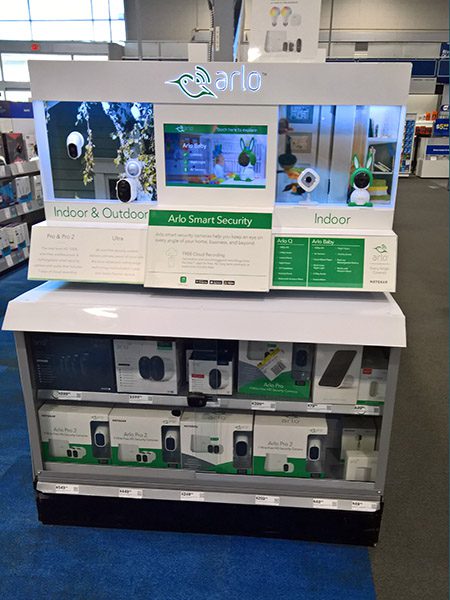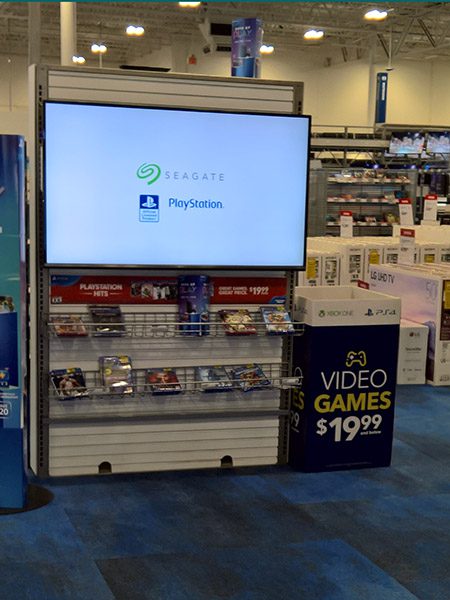
WELCOME TO
INSIGHTS: A DISCUSSION ABOUT “PUBLIC SPACE” DESIGN
Gaddis Architect specializes in all phases of commercial and commercial retail design, design management and construction. If maximizing the success of your business by optimizing the performance of your store, or commercial space design is a goal, then attending the following “Insights” could provide some very real benefits. Many common, and some not so common, design challenges are analyzed. Solutions aimed at increasing retail traffic, creating visual presence in various environments, and expressing not only a particular shopping experience but also the business’s brand, are presented. We think that all design is, on some level at least, retail design. Please scroll on, start a dialogue, contact us anytime.
Digital Signs Increase Sales!
New Service
Curated Content Design, Management, Delivery: There is no shortage of TV’s, monitors, and digital media presentation devices both available and already installed in public spaces. Curated Content for these, on the other hand, is less successful and often non existent. Independent retailers, service providers and non profit organizations are especially susceptible. Landlords, Developers, and Real Estate Agents could use some help too. We already design for this client, representing both visual brands and the spaces in which they are displayed. Curating the digital sign content is a natural conclusions of our efforts in this direction.
We are offering a new digital service. If you are an online and/or “bricks n mortar” retailer, service provider, nonprofit, landlord, developer, real estate agent, in fact most any small business, and interested in installing and/or pushing content to a media kiosk at a physical location of your choice, we invite your participation. No HDMI or special wiring is required, and significant advantages are offered. For details, examples projects and for more information please follow the link.
Why Digital Signage
Real Benefit = Sales: Digital signs, when installed in public places, increases sales. It is a fact! Examples are everywhere as are those who write about them. Irfan Khan, writing a guest post for Sixteen:Nine summed it up better than I ever could.

We designed this display to introduce and explain a new product/service being offered by this “free trial” participant. The composition of the display and the content of the digital presentation has been curated to feature and support the new practice. This is a small display used in a small retail area. Content may be displayed on any size screen so the size of the TV and configuration of the display is a choice not a limitation.
- In public venues digital signs reach more customers than websites or social media.
- Customers engage with them.
- They spend longer looking at digital images than traditional signage.
- They also remember the message.
- Digital signs standout.
- They may drive impulse buying.
- They stay relevant.
- They inspire action.
- They promote featured products and services.
- They showcase a brand.
- They drive sales.
- They shorten wait times.
- They fit into unexpected environments.
- They induce a customer to stay around.
- The results justify the advertising $ spent.
- Businesses give them positive reviews.
Trial and Error is Valuable
Successes: Successful digital signs are physical displays created by the integrations of hardware, electronics, software solutions, and graphic/media content. Without outside help, many small businesses have neither the time nor the resources required to implement a successful digital signage program. Whether small with a single display or large with multiple screens, the implementation process is the same. Finally, presuming all else is perfect, if the content misses the mark then the program is apt to fail. There is no substitute for actual trial and error. In their 2018 Content Management Report Adobe tells us how Alex Honnold tried 50 times before successfully scaling El Capitan. They go on to list these top digital signage challenges:
- Personalization
- Keeping up with current technology
- Difficult-to-use content management systems
- Over-reliance on IT teams for simple functions
- Inadequate access to customer data and insights
- Integrating third-party apps
- Managing and optimizing content
We do not see the need to try 50 times, nor do we claim to have all the answers. We have, though, been practicing and studying the issue for almost two years. We are ready to try out what we have learned and invite you to try with us. Follow the link to learn more.
Digital Signs & Real Products: A Winning Combination?
Inserting a lake, a gym and a hoarse into a display – If marketing guru’s are to be believed, bricks n mortar retailers would be wise to think about how their store designs and related merchandise displays might create an emotional connection between a shopper and the product being sold. It has been suggested that one way to accomplish this is by summoning the context where the product might be used. Does this mean that a diamond ring is better displayed when presented by candle light, flowers, a gourmet dinner? What about a canoe, a pair of sneakers, a cowboy hat, …” Do we need a lake, a gym, and a hoarse to suggest the desired context? So it would appear, especially if we go by design strategies that we see being employed by businesses and retailers who seem to be surviving the effects of online sales.
An obvious way of inserting the lake, the gym and the hoarse into the scenario above is by the use of a digital sign. Since these are clearly showing up everywhere in the public arena, we thought it worth examining how they are being used. To that end we went happily to the epicenter of everyday electronics, Best Buy. Before proceeding, a word about the images used here. These are phone photos taken while I was in the store shopping for a TV which I purchased and will be used on a digital sign. The comments which follow are intended to be instructive on a general topic and reflect on neither the practices and policies of Best Buy, nor the suppliers of the products on display.
Measuring Success – I evaluated each display below for: a) Notice-aibility of the display – 5 pts, b) Brand identity – 4 pts., c) Shopper connection with the context in which the product is presented – 3 pts., d) Shopper engagement with the product – 2 pts., e) Shop-abiltiy of the display – 1 pt. I made a score card, success being assigned according to the order of importance on the list. The highest possible score was 15 points. Click through the images to see who won.
What is the point? – So why go through this exercise? Many of us have been writing about the marketing importance of creating an emotional connection between a shopper and the product being sold. This is certainly important, yet there is another more practical conclusion to be had and it is most evident in the last and final slide in the sequence. It has to do with our preconceived notions about costs, namely the best and most effective display in the sequence was also inexpensive to implement. No customized light boxes, electronic displays, large TV’s or digital display screens are required. Nor are customize informational graphics, merchandise mounting systems, or complicated apps necessary for access to streamed information.
The winner is – The content of the Whirlpool display is no less curated because only a wall, a decal, a logo sign, a small smart TV, a power outlet and merchandise are required. A message is delivered that clearly says, “this washer and dryer is able to provide clean safe clothes for your kids to wear when they are playing outside.” If you are a retailer thinking about introducing technology into a store design, my first recommendation would be not to over complicate what must be done.
Free digital signage trial – Retailers, service providers, and non profits are operating in a new marketing environment requiring that their online and “bricks n mortar” presence be seamlessly integrated. Business are now beginning to understand what museums have known forever; without curation there is only a warehouse. To this end Gaddis Architect will soon be testing a new service designed to provide, manage and deliver curated content for use on digital signs. To be notified about details of our free digital signage trial please join our contact list at the link
Retail Design 2019 – Authentic instead of Augmented
I recently read a blog post entitled “3 Retail Design Trends To Transform 2019.” I thought the article offered a telling view of how retailers are thinking about marketing, and related store planning activities for the new year and beyond. To summarize, not necessarily in order:
Trend Two said basically, when it comes to store design, technology has gone incognito in favor of “connections through context;” meaning conversations with customers and links to community are created by customer interaction with tangible, tactile products.
This is a lot of words to say that if you are a shopper in a hobby and craft store with a compelling display of cake decorating tools, you may, not only pick one of these up and try it out, but also buy it as a gift for your cake decorating buddy who might then share the resource with the entire cake making class. Bingo! You have become an ambassador for the brand and it matters little if you purchased the device at an interactive kiosk, self checkout, or old fashioned POS station, implying that the sale was not made until you were able to hold the actual product in your hand.
Trend Three, still out of order, was about using the physical environment to “empower” – presumably customer – “behaviors” rather than the other way around. The example cited is really esoteric in that everything in the shop has one price: entry into the store, which will, ostensibly, buy the customer a relationship with another person or person(s) through the use of artistic expression operating by way of a convoluted “trade it forward” process. If not very practical, it is definitely thought provoking.
I tried to think of another example of how this might work and could only come up with the idea of one of those chain letters that people send around instructing their friends to “pass it on” or something terrible will happen. This idea was too creepy, even for me, so I decided to ignore it. You can read about the example store at the link.
Trend One, where we find the real substance, suggests that “bricks n mortar” retailers are, indeed, justified in advancing a real product as long as said product makes an emotional connection with the customer. It is an approach that places outcome over experience, motivation over behavior.
Still using the example of cake decoration, I went looking for a suitable visual expression of how it feels to create a valentine for a friend. The image in the photo jumped out at me because, even in the non cake making world, it is totally relatable. If I was a supplier of cake decorating implements, I would use it for a poster on a display targeting the non commercial market.
Lest one get too excited about the prospect of once more advancing a real product, it is probably important to say that accomplishing a “retail design… about creating an emotional connection” is not so easy. Detailed and specific knowledge about the customer base working together with a flexible store design is required for success.









